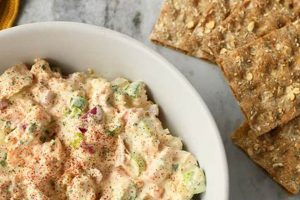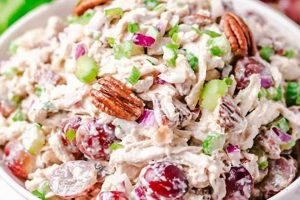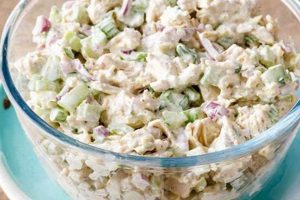A dish combining cooked chicken with ingredients commonly found in Mexican cuisine represents a flavorful and adaptable meal option. Typically, this includes components such as corn, beans, avocado, tomatoes, onions, cilantro, and a vibrant lime-based dressing. Variations can incorporate ingredients like jalapeos, chipotle peppers, or different types of beans, offering a range of flavor profiles from mild to spicy. A simple example involves grilled chicken breast tossed with black beans, corn, diced tomatoes, red onion, cilantro, and a dressing made from lime juice, olive oil, and cumin.
This culinary creation provides a nutritious and satisfying meal, often featuring lean protein from the chicken, fiber from the beans and vegetables, and healthy fats from the avocado. Its versatility makes it suitable for various occasions, from light lunches and picnics to potlucks and family dinners. The fresh ingredients offer a lighter alternative to heavier salads, particularly appealing in warmer climates. While a specific origin point is difficult to pinpoint, the dish likely evolved as a fusion of readily available ingredients in regions with Mexican culinary influences, gaining popularity alongside the broader interest in healthy and internationally-inspired cuisine.
Further exploration can reveal the diverse array of ingredient combinations, dressing options, and serving suggestions that contribute to the widespread appeal of this dish. Understanding the nutritional value and adaptability to dietary needs, as well as exploring regional variations, enhances appreciation for its place in contemporary cuisine.
Tips for Creating a Flavorful Mexican Chicken Salad
Optimizing ingredient selection and preparation techniques elevates this dish from simple to exceptional. Attention to detail ensures a balanced and satisfying culinary experience.
Tip 1: Chicken Selection and Preparation: Utilizing pre-cooked rotisserie chicken offers convenience. Alternatively, grilling or pan-frying boneless, skinless chicken breasts provides greater control over seasoning and texture. Properly seasoned and cooked chicken forms the foundation of a flavorful salad.
Tip 2: Freshness of Ingredients: Opting for fresh produce, particularly ripe avocados, tomatoes, and cilantro, significantly impacts the overall flavor profile. Peak season produce delivers optimal taste and vibrant color.
Tip 3: Balancing Flavors: Achieving a balance of savory, spicy, and acidic elements is crucial. Adjusting the quantities of jalapeos, lime juice, and spices allows customization to individual preferences.
Tip 4: Dressing Considerations: A well-emulsified dressing evenly coats the ingredients and enhances flavor. Whisking together lime juice, olive oil, and spices creates a classic vinaigrette. Alternatively, using a creamy avocado-based dressing offers a richer texture.
Tip 5: Enhancing Texture: Incorporating crunchy elements such as tortilla strips or toasted pepitas adds textural contrast and visual appeal. Consider the interplay of textures for a more engaging culinary experience.
Tip 6: Proper Storage: Storing the salad components separately, particularly the dressing and avocado, prevents premature softening and maintains freshness. Combine ingredients just prior to serving for optimal quality.
Tip 7: Serving Suggestions: Serving the salad in crispy taco shells, on top of tostada chips, or wrapped in large lettuce leaves provides appealing presentation options. Consider the context of the meal when selecting a serving method.
Careful attention to these tips yields a Mexican chicken salad that is both flavorful and visually appealing. The combination of fresh ingredients, balanced flavors, and thoughtful presentation elevates the dish to a satisfying culinary experience.
Through understanding the nuances of ingredient selection, preparation, and presentation, one can create a truly exceptional rendition of this versatile dish.
1. Ingredient Quality
Ingredient quality significantly impacts the overall flavor profile and enjoyment of a Mexican chicken salad. Substandard ingredients diminish the potential of the dish, resulting in a less satisfying culinary experience. Fresh, ripe produce contributes bright flavors and appealing textures. For instance, using a bland, out-of-season tomato versus a juicy, vine-ripened tomato will noticeably affect the salad’s taste. Similarly, employing dry, overcooked chicken breast compared to succulent, properly seasoned chicken will detract from the overall quality. The choice between freshly squeezed lime juice and bottled lime juice further exemplifies the impact of ingredient quality on brightness and acidity.
The inherent flavors of individual components contribute to the layered complexity of the dish. High-quality ingredients amplify these flavors, resulting in a more vibrant and nuanced taste. Consider the difference between using canned black beans rinsed under tap water versus beans cooked from dried and seasoned with aromatics. Or the contrast between store-bought salsa and homemade salsa crafted with fresh tomatoes, onions, and cilantro. These choices directly correlate to the overall depth of flavor achieved in the final product. Employing fresh, vibrant ingredients allows the inherent flavors of the dish to shine through, resulting in a more authentic and satisfying experience.
Selecting top-tier ingredients ultimately elevates the Mexican chicken salad from a simple combination of components to a flavorful and memorable dish. This careful attention to ingredient quality showcases respect for the culinary process and enhances the dining experience. While convenience often dictates ingredient choices, prioritizing quality whenever possible yields significantly improved results. The investment in superior ingredients ultimately translates to a more rewarding and enjoyable culinary outcome.
2. Flavor Balance
Flavor balance represents a crucial element in a successful Mexican chicken salad recipe. This balance involves the careful interplay of several key taste components: savory, spicy, acidic, and fresh. The savory notes, often derived from the chicken itself and potentially enhanced by spices like cumin or chili powder, provide a grounding element. Spicy heat, typically from jalapeos or chipotle peppers, adds a layer of complexity and excitement, but requires careful modulation to avoid overwhelming the other flavors. Acidity, primarily from lime juice, provides brightness and cuts through the richness of the other ingredients. Freshness, derived from cilantro, onions, and other vegetables, contributes a vibrant counterpoint to the richer elements. A harmonious integration of these components creates a dynamic and satisfying flavor profile.
Consider a scenario where the salad relies solely on lime juice for acidity. The resulting dish might taste overly tart and lack depth. Conversely, an overabundance of jalapeos could overwhelm the palate, obscuring the nuances of the other ingredients. A well-balanced Mexican chicken salad, however, strategically incorporates each element, allowing the individual flavors to shine while contributing to a cohesive whole. For instance, the richness of avocado can temper the heat of jalapeos, while the cilantro provides a refreshing contrast to the savory chicken and earthy spices. The interplay of these elements creates a symphony of flavors that engage the palate and enhance the overall dining experience.
Achieving this balance requires an understanding of the intensity of each ingredient and how these intensities interact. It involves a thoughtful approach to ingredient selection and proportion, recognizing that individual preferences may necessitate adjustments. The practical significance of this understanding lies in the ability to create a dish that is not only flavorful but also harmonious and enjoyable. A well-balanced Mexican chicken salad offers a complex yet balanced flavor profile, showcasing the diversity of Mexican cuisine and providing a satisfying culinary experience.
3. Texture Variation
Texture variation plays a vital role in the overall enjoyment of a Mexican chicken salad. A combination of textures elevates the dish beyond a simple mix of ingredients, creating a more engaging and satisfying sensory experience. Consider the contrast between tender chicken, crunchy tortilla strips, creamy avocado, and juicy tomatoes. This interplay of textures adds depth and complexity, preventing the salad from feeling monotonous. Without textural contrast, the dish might feel one-dimensional, lacking the dynamic interplay that stimulates the palate. Imagine a salad composed solely of soft ingredients; the experience would be significantly less interesting than one that offers a variety of textures.
Several elements contribute to textural variation in a Mexican chicken salad. Crispy elements, such as tortilla strips, toasted pepitas, or crumbled bacon, provide a satisfying crunch. Soft elements, like avocado, chicken, and beans, offer a contrasting smoothness. The addition of chopped vegetables, such as onions, tomatoes, and bell peppers, introduces a further layer of textural complexity. Even the choice of lettucecrisp romaine versus tender butter lettuceimpacts the overall texture. Consider, for example, a salad featuring grilled chicken, creamy black beans, crisp romaine lettuce, juicy corn kernels, crunchy tortilla strips, and a smooth avocado dressing. This combination offers a diverse range of textures that enhance the eating experience. The intentional inclusion of diverse textures transforms a basic salad into a multi-dimensional culinary creation.
Understanding the importance of texture variation allows for strategic ingredient selection and preparation. It encourages culinary creativity and the development of a more sophisticated final product. Achieving textural balance requires considering not only the individual textures of the ingredients but also how these textures interact and complement one another. This understanding translates to a more enjoyable and satisfying culinary experience, demonstrating the significant impact of texture on the overall perception of flavor and enjoyment. A well-executed Mexican chicken salad, with its diverse and complementary textures, exemplifies the importance of this principle in creating a truly delightful dish.
4. Dressing Choice
Dressing choice significantly influences the overall flavor profile and enjoyment of a Mexican chicken salad. The dressing acts as a unifying element, binding the ingredients together and imparting a cohesive flavor. A thoughtfully selected dressing complements the other components, enhancing their individual characteristics while contributing to a harmonious whole. An inappropriate dressing, however, can overwhelm the delicate flavors of the salad or clash with its inherent character, detracting from the overall experience. Exploring the various dressing options and their impact on the final product is essential for creating a successful and satisfying dish.
- Classic Vinaigrette
A classic vinaigrette, typically made with lime juice, olive oil, and spices such as cumin and chili powder, offers a bright and tangy counterpoint to the richness of the chicken and avocado. This light and refreshing dressing allows the individual flavors of the other ingredients to shine through, enhancing the overall freshness of the salad. The balance of acidity and oil provides a clean, zesty flavor that complements the other components without overpowering them.
- Creamy Avocado Dressing
A creamy avocado dressing provides a richer, more decadent alternative to a vinaigrette. The avocado adds a smooth, buttery texture and a mild, nutty flavor that complements the other ingredients. This dressing can be particularly effective in salads with bolder flavors, such as those incorporating chipotle peppers or roasted vegetables. The creaminess of the avocado dressing also helps to coat the other ingredients, ensuring a more cohesive and flavorful experience.
- Chipotle Ranch Dressing
For those who prefer a spicier and more robust dressing, a chipotle ranch offers a smoky and flavorful option. The combination of smoky chipotle peppers, tangy buttermilk, and fresh herbs provides a complex and satisfying flavor profile. This dressing pairs well with salads featuring grilled chicken, black beans, and corn, adding a layer of smoky heat that complements the other ingredients. However, it is important to use this dressing judiciously, as its bold flavor can easily overpower more delicate ingredients.
- Honey-Lime Dressing
A honey-lime dressing offers a touch of sweetness to balance the savory and spicy elements of the salad. The combination of honey, lime juice, and cilantro creates a refreshing and slightly sweet dressing that complements the other ingredients without being overly sugary. This dressing can be particularly appealing in salads featuring fruit, such as mango or pineapple, adding a layer of sweetness that complements the tropical flavors.
The choice of dressing significantly impacts the final character of the Mexican chicken salad. While personal preference ultimately dictates the best choice, understanding the characteristics of each dressing and how they interact with the other ingredients allows for a more informed and deliberate decision. Selecting a dressing that complements the other components enhances the overall balance and flavor of the salad, resulting in a more satisfying and enjoyable culinary experience. By considering the various options and their respective contributions, one can create a Mexican chicken salad that is not only delicious but also reflects individual tastes and preferences.
5. Presentation Style
Presentation style significantly influences the perception and enjoyment of a Mexican chicken salad. While flavor remains paramount, visual appeal enhances the dining experience, stimulating appetite and creating a sense of occasion. Thoughtful presentation elevates the dish from a simple meal to a more engaging culinary experience. The manner in which the salad is served affects not only its perceived value but also its practicality for different dining contexts. Consider the difference between a casually tossed salad served in a bowl and a meticulously arranged salad presented on individual plates. The latter suggests greater care and attention to detail, enhancing the overall dining experience.
Several factors contribute to effective presentation. Serving the salad in crisp taco shells offers a fun and interactive element, particularly appealing for casual gatherings. Utilizing tostada chips as a base provides a crunchy foundation and facilitates portion control, making it suitable for appetizers or buffet-style meals. Alternatively, presenting the salad in large lettuce cups emphasizes freshness and offers a lighter, low-carbohydrate option. Garnishing with fresh cilantro sprigs, a sprinkle of chili powder, or a wedge of lime adds visual interest and reinforces the flavors of the dish. For more formal occasions, plating individual portions with carefully arranged elements enhances the perceived elegance of the salad. The choice of serving vessel, whether a rustic wooden bowl or a sleek white plate, further contributes to the overall aesthetic. These considerations demonstrate how presentation style can be tailored to suit the specific dining context and enhance the overall appeal of the dish.
Understanding the impact of presentation allows for a more deliberate and effective approach to serving Mexican chicken salad. Recognizing the interplay between visual appeal and perceived flavor enhances the dining experience and demonstrates culinary expertise. Whether a casual lunch or a more formal dinner, careful attention to presentation elevates the dish, creating a more memorable and satisfying culinary experience. Effective presentation communicates care and attention to detail, transforming a simple salad into a visually appealing and enticing culinary creation.
6. Freshness
Freshness represents a cornerstone of a high-quality Mexican chicken salad. Its significance stems from the direct impact on flavor, texture, and overall enjoyment. A reliance on fresh ingredients elevates this dish, distinguishing it from pre-prepared or less thoughtfully sourced versions. Exploring the facets of freshness within this culinary context illuminates its crucial role in achieving optimal results.
- Produce Quality
The quality of produce significantly influences the final product. Ripe, vibrant tomatoes offer a burst of sweetness and juiciness absent in out-of-season or underripe counterparts. Similarly, crisp lettuce contributes a refreshing textural element, while wilted or browned lettuce detracts from both visual appeal and flavor. Fresh cilantro provides a bright, herbaceous note essential to the dish’s character. Using subpar produce compromises the overall quality and diminishes the intended vibrancy of the salad.
- Chicken Preparation
Freshly cooked chicken, whether grilled, roasted, or poached, offers superior flavor and texture compared to pre-cooked or processed options. Freshly prepared chicken retains its moisture and exhibits a more appealing texture, contributing positively to the overall salad experience. Employing pre-cooked chicken, while convenient, often results in a drier, less flavorful outcome. The attention to chicken preparation underscores the commitment to freshness within the recipe.
- Guacamole and Avocado
Freshly made guacamole or the inclusion of ripe, freshly diced avocado provides a creamy, flavorful element crucial to many Mexican chicken salad variations. Using pre-made guacamole or oxidized avocado compromises both flavor and visual appeal. Fresh avocado offers a vibrant green hue and a smooth, buttery texture, enhancing the salad’s overall aesthetic and palate experience. Prioritizing freshly prepared avocado elements ensures optimal flavor and visual appeal.
- Dressing Vibrancy
A freshly prepared dressing contributes significantly to the salad’s overall freshness. Utilizing freshly squeezed lime juice in the dressing provides a bright, zesty acidity that enhances the other flavors. Pre-made dressings often contain preservatives and lack the vibrancy of freshly made alternatives. The emphasis on a freshly prepared dressing underscores the commitment to quality and flavor optimization.
These interconnected aspects of freshness collectively contribute to a superior Mexican chicken salad. The emphasis on fresh ingredients enhances not only the flavor and texture but also the overall culinary experience. Prioritizing freshness demonstrates a commitment to quality, resulting in a more vibrant, flavorful, and ultimately satisfying dish. Ignoring these elements compromises the potential of the recipe, resulting in a less satisfying outcome.
Frequently Asked Questions
This section addresses common inquiries regarding the preparation and enjoyment of Mexican chicken salad.
Question 1: What type of chicken is best suited for this salad?
While various chicken options suffice, utilizing grilled or rotisserie chicken yields optimal flavor and texture. Pre-cooked chicken breast, though convenient, may result in a drier outcome. Dark meat, such as shredded chicken thighs, can contribute additional richness.
Question 2: Can canned beans be used in place of dried beans?
Canned beans offer convenience; however, dried beans cooked from scratch provide superior flavor and texture. If using canned beans, thorough rinsing removes excess sodium and starch.
Question 3: How can spice levels be adjusted?
Spice level adjustment depends on personal preference. Incorporating diced jalapeos, chipotle peppers in adobo sauce, or a dash of cayenne pepper increases heat. Omitting or reducing these ingredients yields a milder result.
Question 4: What are suitable alternatives to avocado?
While avocado contributes significantly to flavor and texture, suitable alternatives include cooked sweet potato or butternut squash for a creamy texture. Chopped bell peppers offer added crunch and color.
Question 5: How long can the salad be stored?
Proper storage maximizes freshness. Storing the salad components separately, particularly the dressing and avocado, and combining just prior to serving, is recommended. Refrigeration for up to three days is generally acceptable.
Question 6: Can this salad be adapted for specific dietary needs?
Adaptability makes this salad suitable for various dietary needs. Omitting tortilla strips reduces carbohydrate content. Substituting a vinaigrette for a creamy dressing reduces fat. Ensuring all ingredients are gluten-free accommodates gluten intolerance.
Addressing these common questions provides clarity regarding ingredient selection, preparation techniques, and storage recommendations for creating a successful Mexican chicken salad. Understanding these aspects allows for customization and enjoyment of the dish across a range of preferences and dietary needs.
Further exploration of variations and serving suggestions expands the possibilities of this versatile and flavorful dish.
Mexican Chicken Salad Recipe
Exploration of this culinary concept reveals a dish offering significant versatility and flavor. Key elements, including ingredient quality, flavor balance, texture variation, dressing selection, presentation style, and freshness, contribute to the overall success of a Mexican chicken salad. From the careful selection of ripe produce to the nuanced interplay of savory spices, zesty lime, and creamy avocado, each component plays a vital role in creating a harmonious and satisfying culinary experience. The adaptability of this dish to various dietary needs and preferences further enhances its appeal. Understanding the interplay of these factors allows for informed choices regarding ingredient selection, preparation methods, and presentation, ultimately resulting in a more enjoyable and rewarding culinary outcome.
The continued exploration of flavor profiles, ingredient combinations, and presentation styles within the realm of Mexican chicken salad promises further culinary innovation. Appreciation for fresh, high-quality ingredients and thoughtful preparation techniques remains paramount in realizing the full potential of this versatile dish. Culinary experimentation and adaptation based on individual preferences and dietary needs further solidify its enduring appeal and position it as a staple within the diverse landscape of contemporary cuisine.






